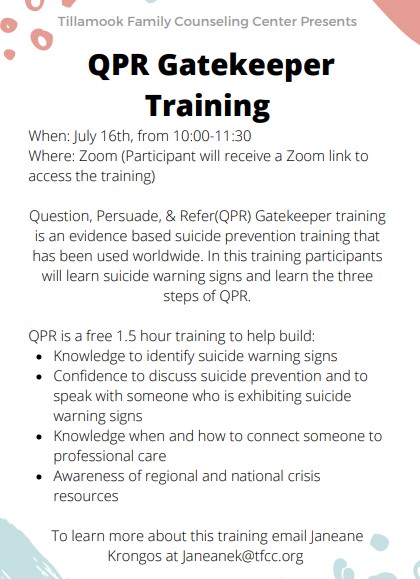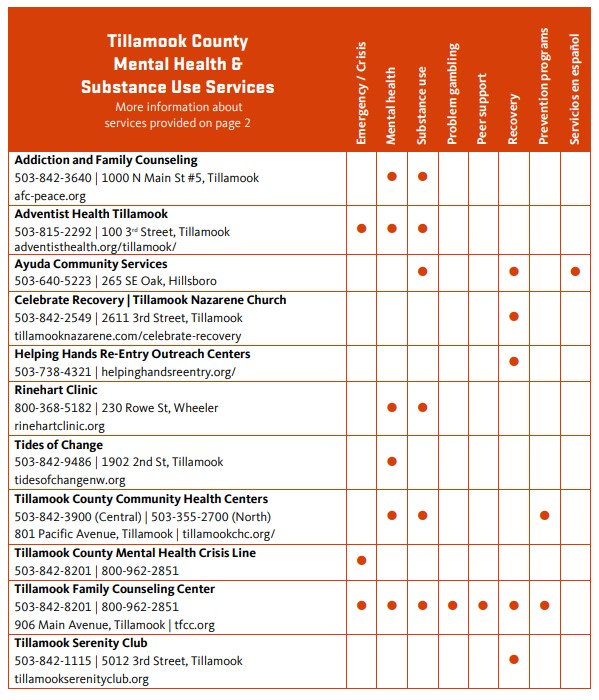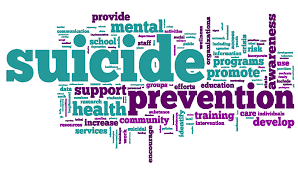By Laura Swanson
Our hearts go out to all those impacted by suicide, and after especially tragic suicides this weekend, the Pioneer is calling on our community to reach out to those that may be experiencing depression or grief. Check-in with friends or family, or simply send a message “thinking of you today” to everyone on your contacts list. That just might save a life … sometimes that’s all it takes to bring someone back from the edge, or to help them reach out. The two lives lost this weekend will have a ripple effect, impacting dozens of family members, friends and the community.
Here is information for survivors of suicide – the friends and family left behind – with resources and information on how we as a community can help, and provides hope. How to Help a Loved one after a Loss
The Tillamook County Pioneer has provided ongoing outreach and education about suicide prevention in our community through community partners – SOS Tillamook, Tillamook Family Counseling Center, OSU Extension, Tillamook County Wellness, Adventist Health with events, movie screenings, community conversations and trainings. There is another FREE QPR* training available July 16th from Tillamook Family Counseling – see more below for more information. We are determined to “break the silence” by talking about suicide, with responsible reporting about this public health crisis and the solutions we are trying to build as a community.
We are facing a public health crisis of suicide – but we also know that for every person who dies by suicide, there are 280 people who seriously think about suicide — but instead choose to live. That’s 280 remarkable stories of hope and healing. The Tillamook County Pioneer is committed to providing information and outreach and will continue taking the remarkable step to tell those stories, in the context of the public health crisis, to help break the silence on suicide, erase stigma, and launch an overdue and public conversation about suicide prevention and mental health supports. We know as long as suicide is in the shadows, we fuel the stigma to getting help – we make it so that people in need suffer alone, rather than reaching out to the help and hope we all work to provide.
People arrive at suicide crisis for many reasons but, typically, it’s because they’re overwhelmed by a problem they may not be able to solve themselves. Stress becomes anxiety if left unchecked. Anxiety can lead to depression. Depression can lead to hopelessness that can lead to a person with thoughts of suicide. Left unchecked, an adverse experience such as bullying or loss of a friendship at school can be the tipping point. Without outside help, he or she could easily become overwhelmed with the situation and such situations can, and do, lead to thinking about suicide.Another example of a person who may be in crisis is a person with a mental illness, particularly if they’re not in treatment, may be driven to suicidal feelings because of an illness they didn’t ask for and cannot control. A person with mental illness will need professional help to get them out of crisis.
Let’s flip the perspective. When training is provided, often we talk about what is the perspective of the person with thoughts of suicide? To really know how to approach them, you need to understand their lens. Too often, a person in a crisis state cannot see anything but their pain: physical and/or emotional pain. Their perspective becomes myopic and colored with feelings of hopelessness. They cannot see the hands reaching out to help or the resources taped to the wall. This too often becomes frustrating for the friends and loved ones of the person at risk.
When approaching a person with thoughts of suicide, even for the 10th time, must be without judgement or opinion. Most people that approach a loved one are NOT counselors and cannot fix them. What we can do is widen the lens in which the person sees their world by offering hope in any positive manner. Once they can see a bigger picture — a little bit of light — it is only then we can persuade them to get help. Often a person with suicidal thoughts believe they cannot be helped, so you may have to do more. Have resources near you so that you can offer “suggestions.”

Print out the phone numbers below or save this graphic on your phone so you have these numbers handy to share with someone that might just need someone to talk to …
 *Virtual Question Persuade Refer(QPR) Gatekeeper training July 16th, from 10:00 to 11:30 am The QPR Gatekeeper training is a community mental health intervention that was listed on SAMSHA’s National Registry of Evidence Based Programs and Practices as an effective suicide prevention training. This training was designed to be beneficial for all adults, including: parents, teachers, employers, health staff, and hospitality staff. This training will be offered at no cost to the participant (registration for this training will be limited to 20 participants that reside or work in Tillamook County). If you would like to register for this virtual QPR training please contact Janeane Krongos at JaneaneK@TFCC.org or by calling (503)842-8201.
*Virtual Question Persuade Refer(QPR) Gatekeeper training July 16th, from 10:00 to 11:30 am The QPR Gatekeeper training is a community mental health intervention that was listed on SAMSHA’s National Registry of Evidence Based Programs and Practices as an effective suicide prevention training. This training was designed to be beneficial for all adults, including: parents, teachers, employers, health staff, and hospitality staff. This training will be offered at no cost to the participant (registration for this training will be limited to 20 participants that reside or work in Tillamook County). If you would like to register for this virtual QPR training please contact Janeane Krongos at JaneaneK@TFCC.org or by calling (503)842-8201.
If you are in crisis now, contact the National Suicide Prevention Lifeline at 1-800-273-TALK (8255)
•To chat online with a counselor, click here: http://www.suicidepreventionlifeline.org/GetHelp/LifelineChat.aspx
•The National Suicide Prevention Lifeline website: http://www.suicidepreventionlifeline.org/
•For the hearing impaired, contact the Lifeline by TTY at: 1-800-799-4889
Here are more local resources available:



